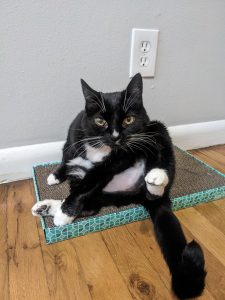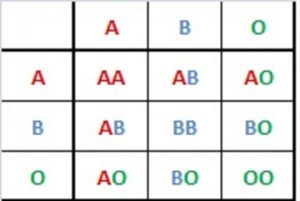White spotting: When there’s more than two alleles
Table 2: Combinations of different alleles for MITF result in different amounts of white present in the coat.
| Alleles | Amount of white |
| SS | None (solid colored) |
| Ssi | Small amounts of white possible on face, chest, feet, and tail tip |
| Ssp | More than 50% solid colored, with white on the face, chest, feet, collar, underbelly, and tail tip |
| sisp | Approximately even amounts of color and white |
| sise | More than 50% white with irregular splashes of color |
| sese | Mostly white with only minimal areas of color, perhaps on one or both ears, an eye patch, or a spot near the tail |

There is a similar white-spotting gene in domestic cats that leads to the bicolor coat pattern commonly called “tuxedo” (Figure 2). However, the genetic causes of domestic cat coat patterns are not well understood and there is no consensus on which specific gene controls white spotting in cats. Some studies suggest that the gene responsible is the feline version of the KIT gene (Cooper, et al. 2006; Montague, et al. 2014), but further research on mammalian pigmentation is needed before a conclusion can be made (Mort, et al. 2016).

Human Connection – Blood Type
Human blood type was discussed in the previous section. You may remember that there are three alleles for the ABO gene: A, B, and O. A and B are codominant, meaning that if both alleles are present, both will be seen in the phenotype. A person with type AB blood has one A allele and one B allele.
O is recessive to A and B. A person with the genotype AO will have Type A blood. A person with the genotype BO will have type B blood. Type O blood results from two O alleles.

Photo credit: Kalaiarasy, from Wikipedia.
References
Unless otherwise noted, text and images by Lisa Bartee (2016) and Catherine Creech (2023).
Karlsson EK, Baranowska I, Wade CM, Salmon Hillbertz NH, Zody MC, Anderson N, Biagi TM, Patterson N, Pielberg GR, Kulbokas EJ 3rd, Comstock KE, Keller ET, Mesirov JP, von Euler H, Kämpe O, Hedhammar A, Lander ES, Andersson G, Andersson L, Lindblad-Toh K. 2007. Efficient mapping of mendelian traits in dogs through genome-wide association. Nat Genet. 39(11):1321-8.
Montague MJ, Li G, Gandolfi B, Khan R, Aken BL, Searle SM, Minx P, Hillier LW, Koboldt DC, Davis BW, Driscoll CA, Barr CS, Blackistone K, Quilez J, Lorente-Galdos B, Marques-Bonet T, Alkan C, Thomas GW, Hahn MW, Menotti-Raymond M, O’Brien SJ, Wilson RK, Lyons LA, Murphy WJ, Warren WC. 2014. Comparative analysis of the domestic cat genome reveals genetic signatures underlying feline biology and domestication. Proc Natl Acad Sci USA. 111(48):17230-5.
Cooper MP, Fretwell N, Bailey SJ, Lyons LA. 2006. White spotting in the domestic cat (Felis catus) maps near KIT on feline chromosome B1. Anim Genet. 37(2):163-5.
Mort, R. L., Ross, R. J. H., Hainey, K. J., Harrison, O. J., Keighren, M. A., Landini, G., Baker, R. E., Painter, K. J., Jackson, I. J., & Yates, C. A. 2016. Reconciling diverse mammalian pigmentation patterns with a fundamental mathematical model. Nature Communications, 7(1), 10288.

